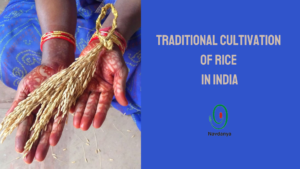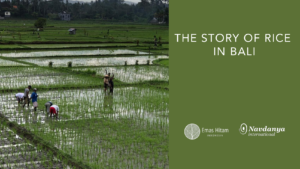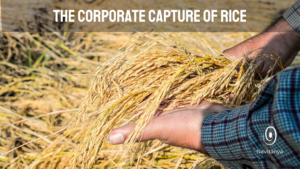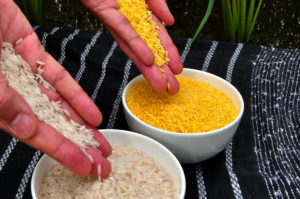As one of the most important and most widely produced staple crops in the world, the story of rice is deeply tied to place and time. Throughout Asia, has always had a deeper significance than just a basic food, it holds an important place in cultural ceremonies and rituals, is a connector and creator of community and a symbol of heritage. Throughout time and in direct relation with the diversity of ecosystems, farmers have developed a tremendous diversity of rice, all linked to specific knowledge systems, and with some being able to flourish in extreme conditions. This heritage of traditional cultivation rice systems have given resilience, ensured livelihood and adequate nutrition for millennia to local food communities.
But since the beginning of the Green Revolution, there has been a corporate push to capture, ‘improve’ and introduce industrialized rice systems based on hybrid, and now GMO rice, chemical inputs and genetically uniform monocultures. The attempt to capture and consolidate the variety of rice growing systems into a singular profitable market has taken place through methods such as, direct biopiracy of resilient traits, illegal patenting, and the centralization of rice seed into the seed banks of international research institutions which are inaccessible to farmers. The Imposition of GM Golden Rice now acts as the most recent attempt to further impose the failed industrial model, only made possible by the previous destruction of traditional cultivation systems. Especially since the story of the corporate capture of rice has led to a series of negative effects, like the decline of available seed diversity, the elimination of livelihoods, environmental and nutritional degradation, and the destruction of ancient traditional lifeways.
The Story of Rice is, therefore, a complex comparison between traditional rice cultivation systems and their cultures, and the effect of the destruction they have undergone through the imposition of a predatory industrial model.
INFOGRAPHICS – Download Image Files – Download pdf
 Traditional Cultivation of Rice in India
Traditional Cultivation of Rice in India
Rice has a long and deep history in the Indian subcontinent and forms a central part of almost every aspect of daily life– whether through its symbolic place in religious and ceremonial rites, its culinary importance as both a staple and gastronomic food, and its agrarian rhythms which have punctuated life in the field for millennia. This farmer and crop relationship throughout time has developed a huge array of crop diversity, knowledge systems and cultural significance in each micro bioregion of India. Leading to the fomentation of vast amounts of biodiversity, cultural diversity, and traditional lifeways. Featuring selections from various Navdanya reports and collaborative works, this paper highlights the intertwined diversity in rice cultivation systems in India. Download PDF
Among the topics covered:
- Domestication and Centers of Origin
- Preparation of land
- Temperature and humidity for Indica rice varieties
- Seed treatment, preparation and sprouting
- The Diversity of Cultivation Systems- Dry and Wet Cultivation
- Orissa’s Beusaning and Chhattisgarh’s Biyasi Cultivation Methods
- Variety Diversity and Biodiversity in the Field
- Drought Resistance
- Flood Resistance
- Salinity Resistance
- Aromatic rice
- Traditional Significations and Medicinal Uses of Rice
- Religious significance
- Pests & Disease Control with Biodiversity
- Harvest, Storage and Uses
- The Example of Chhattisgarh

The Story of Rice in Bali
When farmers started growing rice in ancient times, it was seen as a blessing from the Gods. Today, rice is still sacred, forming a central part of every ceremony as an offering, as a ceremonial food, and sacred symbol. For example, rice is used as a bija and placed on the third eye. Balinese rice culture is hence seen as a source of reputation, recognition, and most of all, a source of sacred livelihood. Because of this, local seeds have always contributed to the unique identity of each part of Bali. Throughout time these rice varieties have co-evolved and adapted to the landscape, climate, water, environmental conditions, and people’s needs, forming a central part of the reproduction of Balinese life. Download pdf
Among the topics covered:
- History of Rice in Bali: The cultural and religious significance of rice
- Local Rice Varieties
- The Subak System and the Tri Hita Karana Philosophy
- The Tri Hita Karana Philosophy
- The Impact of Industrial Farming and the Green Revolution
- The Water Crisis and Current Threats to the Subak System
- What’s the future for food systems and rice cultivation in Bali?
- Mari Berkebun Next- The Building of a New Rice Communities
 The Corporate Capture of Rice
The Corporate Capture of Rice
As one of the most important staple crops in the world, there have been systematic attempts to capture and capitalize on the huge array of rice diversity by international institutions and big agribusiness and biotech companies. Whether it’s through patenting, the capture of seed diversity into centralized seed banks, direct biopiracy, or imposing hybrid rice varieties on small farmers to extract profits, the story of the corporate capture of rice set the stage for the latest imposition of GM golden rice. This paper pieces together part of this story based on a collection of various Navdanya reports and collaborative work with other Asian organizations, to bring to light the multidimensional effects of the capture of rice. Download PDF
Among the topics covered:
- The History of Biopiracy Cases in India
- Biopiracy of RiceTech and Basmati in 2001
- Syngenta’s Biopiracy of India’s Rice Diversity
- Corporate Capture in Bangladesh
- Corporate Capture in the Philippines
- The Threat to Seed Sovereignty: Patents, Seed Law and GMO Contamination
- Decline in Diversity

Dr.Vandana Shiva, Gates to A Global Empire, Navdanya International, October 2020
The history of the push for Golden Rice, a GMO rice, turned golden from biofortified beta-carotene, funded through IRRI by the Gates Foundation, has been promoted since 2000 as a possible solution to Vitamin A deficiency. Dr. Shiva shows us how a genetically modified rice strain is not necessary to provide vitamin A in Asia, and how those pushing Golden Rice are ignoring the biodiversity-based solutions to nutritional deficiencies already present. Especially as in June 2018, the FDA concluded that Golden Rice does not meet its nutritional claims of providing enough daily beta-carotene. Golden Rice is instead a further imposition of a detrimental industrial model.
Further Resources about Golden Rice:
Genetically Engineered Vitamin A Rice: A Blind Approach to Blindness Prevention, Dr.Vandana Shiva, Research Foundation for Science, Technology, and Ecology (2000),
THE “GOLDEN RICE” HOAX – When Public Relations replaces Science, Dr.Vandana Shiva, Research Foundation for Science, Technology, and Ecology (2000),
Biodiversity Or Gmos: Will the Future of Nutrition be in Women’s Hands or Under Corporate Control?, Navdanya, March 2015,
BMG Foundation and IRRI: Corporate Hijack of Rice Science – Charito P. Medina, Gates to a Global Empire, Navdanya International, October 2020
Let’s reclaim ‘Akshat’ – Dr. Vandana Shiva, Deccan Herald, 2 January 2021
Defend Our Rice! Farmer-scientist group condemns Golden Rice commercial propagation, calls on farmers and consumers to protest – Masipag, 23 July 2021
Why We Oppose Golden Rice – Stop Golden Rice Network, Independent Science News, 7 August 2020
Philippines: Farmer-scientist group condemns Golden Rice approval – Masipag, 19 December 2019
IRRI and the Corporate capture of Food and Agriculture – Online event by Stop Golden Rice Network, in collaboration with Masipag Philippines and Navdanya International, 4 April 2023
Videos about Golden Rice
Partners


